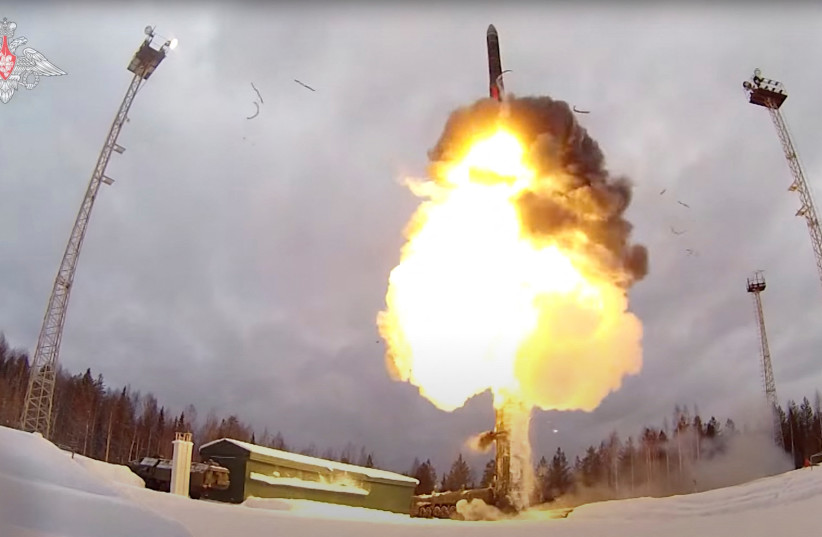by Anna Ahronheim
The IDF will study footage released on social media as well as all the military power being used by both sides in order to better prepare for the next war that it will be engaged in.
At five o’clock on Thursday morning, Russia fired hundreds of missiles toward Ukraine in what was the beginning of its full-scale invasion of the European country that declared its independence from Moscow in 1991.
It is a war that will showcase Russia’s military might against Ukraine and Western weapons systems. If Russia’s latest weapons were tested in Syria, they are now being battle-proven in Ukraine.
It is also being played out on social media – videos have already circulated of missiles flying over Ukraine, with some reports indicating that they could be naval Kalibr or Iskander ballistic missiles or cruise missiles fired by Russian jets toward strategic Ukrainian targets, including military airfields, air defense systems, ammunition depots, infrastructure and more.
After the initial missile barrages that may have been launched by multi-rocket launch systems like the 9A52-4 Tornado, Russian tanks were filmed crossing into Ukraine as well as jets and helicopters flying over Ukrainian cities and towns.
 A Russian Yars intercontinental ballistic missile is launched during
the exercises by nuclear forces in an unknown location in Russia, in
this still image taken from video released February 19, 2022. (credit:
Russian Defence Ministry/Handout via REUTERS)
A Russian Yars intercontinental ballistic missile is launched during
the exercises by nuclear forces in an unknown location in Russia, in
this still image taken from video released February 19, 2022. (credit:
Russian Defence Ministry/Handout via REUTERS)While reports out of a war zone are always tricky, Ukraine reported that at least six fighter jets and one helicopter were downed by their air defenses on Thursday morning.
It was just the beginning of a war that Israel’s military will be keeping a close eye on in order to learn what they might face in a future war on its northern front, where Syrian forces have been trained by and received military aid from Russia.
Both Ukraine and Russia have been upgrading their militaries in recent years, but Russia far overpowers Ukraine in terms of personnel (850,000 vs 250,000) and weaponry. In terms of airpower, Russia has 4,100 aircraft compared with 318 Ukrainian aircraft.
Russia has one of the most powerful militaries in the world, and spent $61.7 billion on its military in 2020. According to Global Firepower, which analyzes the military capabilities of countries around the world, Russia is the second-most powerful military in the world. Ukraine meanwhile is ranked 22 out of 140 globally.
Prior to the invasion, Russia had an estimated 200,000 troops deployed on Ukraine’s borders, and also deployed Iskander short-range ballistic missile systems, tanks and artillery. Moscow began its attack at night and waited until morning to start moving their ground forces into place.
ISRAEL WATCHED closely when Russia tested various platforms in Syria,
and will be watching even more closely to see if they can take on the
Western arms provided to Ukraine. The IDF will also be watching how the
Russian military moves its forces and uses its heavy armored vehicles
and tanks in urban areas.
Though the IDF has been investing in precision munitions that can be fired from standoff ranges in order to reduce the risk to ground forces, tanks and armored fighting vehicles remain a central aspect of any battle in which the IDF engages.
No IDF tanks have maneuvered into dense urban areas since Operation Protective Edge, the 2014 war in the Gaza Strip, and before that the Second Lebanon War in 2006. The Israeli military will look to learn lessons from any urban combat that might be conducted by the Russians in this war. The Ukrainian response to Russian tanks will also be studied by Israel.
While most of Kyiv’s military is based on antiquated Soviet systems, it has received new equipment from the West including Javelin anti-tank missiles, Stinger anti-aircraft missiles, and Turkish-made Bayraktar drones that could be a game-changer.
Turkish- and Israeli-made drones were key platforms in another recent war that involved Russia: the 2020 conflict between Armenia and Azerbaijan, when small tactical drones ripped through Armenian tanks and even Russian air defenses.
Though Kyiv is no major drone power and does not have any Israeli-made drones, Ukraine’s military has been fielding an array of small tactical drones since 2014 – some that can survive GPS jamming – and while they alone won’t defeat the Russian military, they likely could become a deadly nuisance.
Among the drones in its arsenal is the Yatagan-2 (“Scimitar”) drone that can cruise for up to 12 minutes searching for targets before diving into one with a two-pound explosive, or the fixed-wing drone called the AN-BK1 Horlystisa made by Antonov (which has built some of the world’s largest transport planes) that are capable of carrying munitions to engage targets.
The IDF is a military that praises itself for its in-depth investigations and its ability to incorporate battlefield lessons. While Israel’s military will very likely watch Europe’s war from the sidelines, it will watch it closely. It will study the tweets, Snapchats, Instagram stories and other footage released on social media as well as all the military power being used by both sides, in order to better prepare for the next war in which it will be engaged.
Anna Ahronheim
Source: https://www.jpost.com/middle-east/article-698498
No comments:
Post a Comment